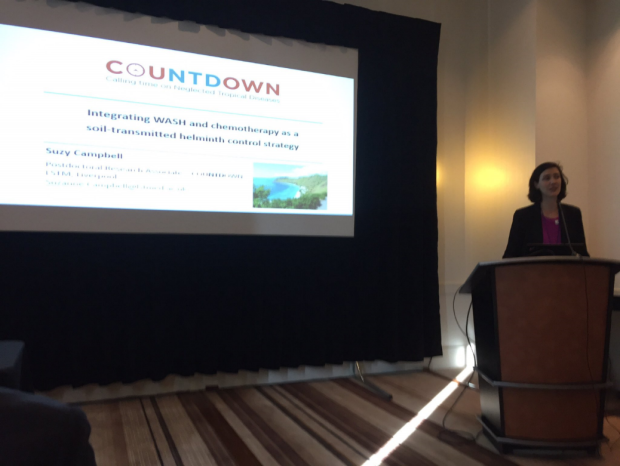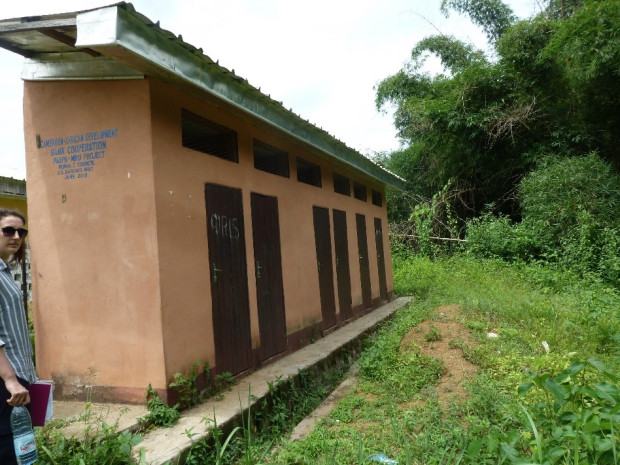By Dr Suzy Campbell & Dr Nana-Kwadwo Biritwum
There is a very important research agenda gaining momentum at present, and it is attracting extensive stakeholder buy-in. This is the importance of water, sanitation and hygiene (WASH) in augmenting preventive chemotherapy for neglected tropical disease (NTD) control. We chaired a breakout session at COR-NTD, the annual operational research meeting for NTDs, held in Atlanta in November. We highlighted the important strategic agenda for strengthening evidence on how to deliver effective WASH interventions for schistosomiasis and soil-transmitted helminthiases (STH), and embedding these findings in guidance and practice. In this blog we share why this is such an important integration priority!

Figure 1: Dr Suzy Campbell presenting at COR-NTD (Photo: L. Hamill)
Since the early 2000s, preventive chemotherapy (“PC”, being provision of deworming tablets) has been the cornerstone morbidity-control strategy for Lymphatic Filariasis, Onchocerciasis, Schistosomiasis, STH, and Trachoma. PC is most often provided by repeated mass drug administration (MDA) campaigns, usually targeting treatment to school-aged (and school-attending) children. This approach has rightly, had strong World Health Organization (WHO) advocacy, and is considered the largest-scale repeated public health programme in the world.
However, for schistosomiasis and STH, it has been known from the outset that PC alone does not reduce the rapid cycle of reinfections. People continue to be exposed to these parasites from their environments. For schistosomiasis in particular, transmission can be continued from just one or two individuals who contaminate the environment subsequently infecting intermediate snail hosts. For these two diseases, the approach has been one of “morbidity control” rather than disease control.
MDA has been conducted for up to a decade in many endemic regions of the world, and whilst coverage of school-aged children is progressing towards WHO targets, there are multitude reasons for strengthening additional strategies, such as provision of WASH. Continuation of this is still crucially important, but additionally there is increasing focus towards other strategies that will augment PC. Since 2012, there has been much discussion on moving beyond “morbidity control” to “interruption of transmission” and “elimination as a public health problem”.
So what is WASH and why is it important?
WASH is the provision of access to a safe water supply, appropriately constructed sanitation infrastructure ensuring safe disposal of human excreta, and health education and promotion of hygiene (being personal and household practices aimed at preserving cleanliness and health).

Figure 2: Integration challenges: these brand new toilets remain locked (Photo: S. Campbell)
For disease control purposes, WASH needs to be viewed both according to the individual components of water, sanitation, and hygiene (including health education as a main conduit of hygiene promotion), and additionally, as an integrated system. This is because the components are complementary: infrastructural components such as provision of public taps or household latrines are unlikely to be beneficial investments without accompanying behavioural change (or vice versa). Just as PC can be seen as the cornerstone of morbidity control, WASH can be viewed as the cornerstone of prevention of infections. From a position of biological plausibility, WASH is the key mechanism that can be implemented to reduce environmental contamination and then, quite possibly, transmission.

Figure 3: A drain where people wash their clothes (Photo: S. Campbell)
Despite this, the evidence base for WASH activities for STH or schistosomiasis control is fairly weak and it is a growing research priority. We crucially need more information as to the elements of WASH programmes that are most beneficial for STH and schistosomiasis control. This needs to encompass not only the more commonly-discussed water collection and/or toileting habits, but also extend to other potential elements such as grey water disposal and contribution of animal faeces (given zoonotic potential for some helminths).
What is happening right now?
In 2012 the WHO released the NTD Roadmap, which set NTD coverage targets to 2020 and fostered unprecedented anthelmintic and financial donations. This led to major international momentum, strongly supported by WHO, for countries to develop strategic NTD master plans tailored to national NTD control and elimination priorities. To a very large extent these actions have redefined the international STH and schistosomiasis agenda, being a major push to assist some countries to achieve STH coverage targets.
In late 2015, the WHO published the first WASH for NTDs Global Strategy 2015-2020, providing four strategic objectives to accelerate progress on addressing NTD Roadmap targets through increased intersectoral WASH-NTD collaboration and integration of approaches. This much-awaited document provides international impetus to countries to prioritise WASH in conjunction with other NTD control strategies. The intention is that WASH activities be developed and built into country NTD programmatic planning.
However, in order to do this, we need to strengthen the evidence for delivery of effective WASH interventions for NTDs. Additionally, we need to embed these evidence findings in guidance and practice. This is the clearly stated objective, and call for assistance, of one of the Strategic Objectives in the WASH for NTDs Strategy. In this, the WHO is calling for research evidence, and programmatic examples to be shared.
Considering schistosomiasis and STH, this is a fundamentally important requirement. We know we can’t control these diseases without primary prevention strategies. This important distinction for these two NTDs needs to be explicitly made, compared to many other NTDs: WASH for schistosomiasis and STH control needs to be seen as a major determinant of disease prevention. This is radically different from NTDs such as lymphatic filariasis, where WASH can be used as a treatment strategy (for example, washing of hydroceles for morbidity management). For STH and schistosomiasis, WASH is not to treat, it is to prevent.
WASH for schistosomiasis and STH control at COR-NTD
What we focused on for COR-NTD in our discussion workshop was the importance of this prevention agenda for schistosomiasis and STH. With a strong introduction to the WHO WASH for NTD Strategy from Dr Amadou Garba (WHO), several country-specific research and NTD programme case studies were presented, as follows: Ghana (Dr Nana-Kwadwo Biritwum, National NTD Programme Coordinator, Ghana), Cameroon (Prof Louis-Albert Tchuem-Tchuenté, National NTD Programme Coordinator, Cameroon), Tanzania (Dr Steffi Knopp, Natural History Museum, UK), Ethiopia (Dr Jack Grimes, World Vision, UK), Timor-Leste (Dr Suzy Campbell, LSTM, UK), with current WASH evidence for schistosomiasis and STH summarised (Jack Grimes and Suzy Campbell). Dr Lorenzo Savioli (Chair of Executive Group, Global Schistosomiasis Alliance) then gave a compelling historical perspective of more than 30 years of PC-based control in Zanzibar (Tanzania), clearly highlighting shortcomings of STH and schistosomiasis control strategies in the absence of sufficient WASH investment. The audience of expert NTD attendees then participated in a lively discussion about evidence requirements, WASH indicators for NTDs, schistosomiasis hot-spots, more use of mathematical modelling and advanced diagnostic tests, integration challenges, and learning from other disease programmes. Key discussion points, knowledge gaps, and important next steps are summarised in the session report.
Our session integrates closely with another important WASH for NTDs session held at the NTD Non-Government Development Organisation (NGDO) Network Meeting in Washington DC in September (chaired by our collaborator Dr Fiona Fleming at the Schistosomiasis Control Initiative, as the first two major stakeholder pushes to investigate country examples and share learning in light of the WHO Strategy. We believe these are important, but preliminary, indications of the need for an investment case for WASH for NTDs. Much needs to be done to develop this; in the meantime, it is clear that integrated, multi-stakeholder support will be a critical factor for the WHO Strategy’s success. We should all contribute to this.
Please read the summary report of the session on the COR-NTD website, and our Storify.
